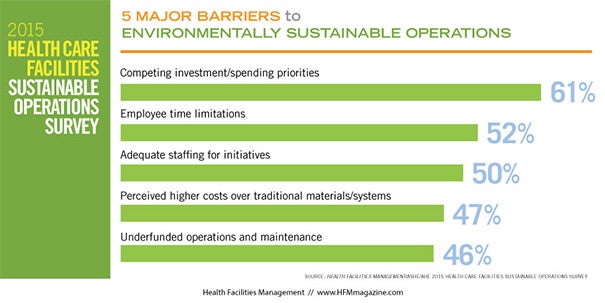Time limitations a big barrier to hospitals going green
It takes time and money to make things happen, and that certainly proves true when examining the results of our 2015 Sustainable Operations Survey. The results of this year's survey showed many similarities to the last one conducted in 2013. For instance, competing investments/spending priorities remained the top barrier to implementing environmentally sustainable initiatives. Following closely were employee time limitations and inadequate staffing for initiatives.

|
Our reporter for this year's survey spoke with many health care facility and sustainability experts who each weighed in on what health care facilities are and are not doing when it comes to environmental stewardship and why. Tom Thompson, sustainability coordinator at Gundersen Health System, says the issues of time and money actually can be linked in regard to pushing sustainable initiatives through. Not only do you have to have the money to implement green programs, you have to have the time to advocate for that money and prove it's worth the investment.
"We all have it in the front of our minds that we are here to do the right thing for the environment and the health of our community, but we also strive to be economically responsible as well," Thompson explained. "We have to fight for budget dollars — they're not just handed to us."
Fighting for budget dollars, however, can be a difficult thing when there is no designated leader at the helm. Fifty-four percent of survey respondents said their health facility or health system did not have a dedicated sustainability officer and 46 percent did not have a formal sustainability program communicated to all staff.
Those data points could be the reasons for the underlying theme in this year's report — while a few health systems reach high for big sustainability projects, such as investing in renewable energy or switching to sustainable flooring materials, the majority stick with the low-hanging fruit that don't take as much time, staffing or money, but still have a significant to adequate payback, i.e., switching to LED lighting, and using microfiber mops and cleaning cloths to reduce water and chemical use.
As the low-hanging fruit is consistently picked off and the more innovative systems continue making big strides, Robin Guenther, FAIA, LEED Fellow, principal of Perkins+Will, says it may encourage more health care facilities to move on to bigger projects.
"In general, you're only going to see large numbers of hospitals implementing new programs if a small group of innovative hospitals have done it first," she says in this year's report. "People want to see what they're talking about in action."




